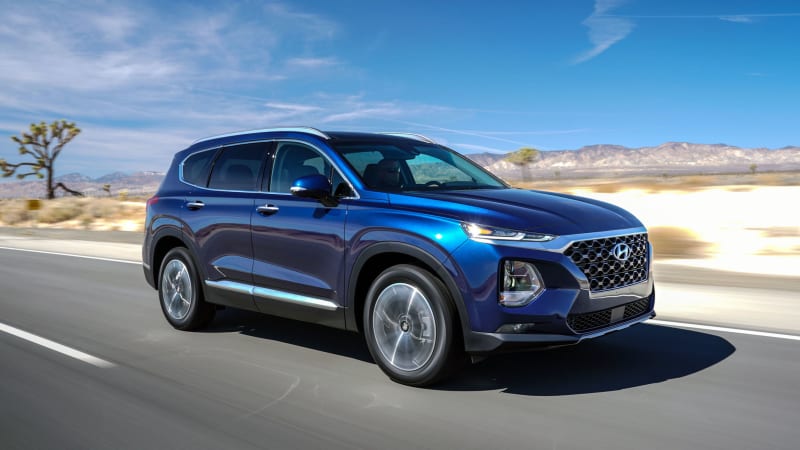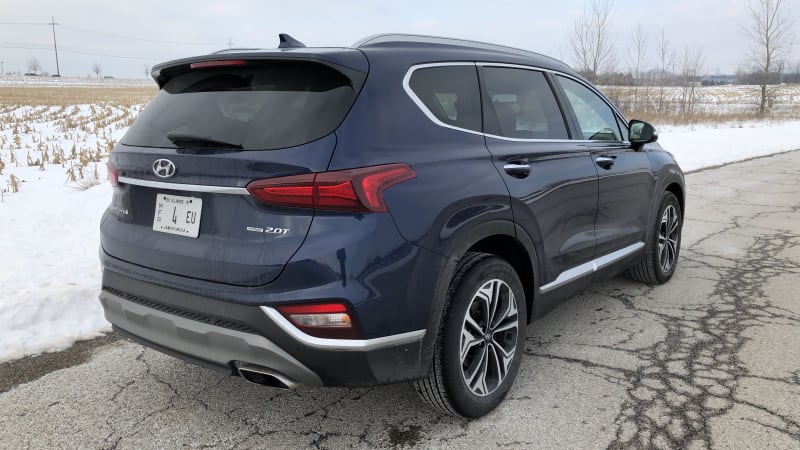2020 Hyundai Santa Fe Review & Buying Guide | Ho ho ho, it’s Santa (Fe)
https://ift.tt/2sjyQMO
The 2020 Hyundai Santa Fe fits into an interplanetary orbit between compact and midsize SUVs. Its size and more premium vibe are a little closer to the midsizers, while its standard engine and price tag are more comparable to the compacts. And for a lot of folks looking for an SUV in the $30,000 range, that should be a combination that makes a ton of sense. That it manages to look as good as it does inside and out should also be appealing to those who’d rather not drive something dull and drab that screams “family vehicle!”
So why should you think twice? It’s actually a bit dull and drab to drive to be honest, and the more appealing turbo engine is exclusive to the priciest versions. It’s also not the most rugged of family crossovers, with mediocre ground clearance and less functional roof racks. A Honda Passport or Subaru Outback would be a better fit for the Patagonia-clad set. For everyone else searching in either of those compact or midsize orbits, it should be considered a must-drive.
What’s new for 2020?
The Santa Fe was all-new last year. For 2020, trim levels have been reorganized. There’s now SE, SEL and Limited, while the SEL gains Convenience, Premium and Infinity Premium Audio packages. The former range-topping Ultimate trim has been discontinued, but the Limited gains all of its equipment as well as its higher price. On the other end of the trim spectrum, blind-spot and rear cross-traffic warning are no longer available on the base SE. It’s still standard on all other trims. Wireless charging is also now available as an option on the SEL trim as part of the Convenience package and Hyundai’s excellent blind-view monitor is now included on the Limited.



What’s the interior and in-car technology like?
Smooth, curving horizontal lines and surfaces grace the dashboard and doors, providing more of an organic appearance than you’ll find in competitors like the Honda Passport or Ford Edge. Soft-touch surfaces are plentiful, as even the dash has a soft, squishy feel to it. The switchgear isn’t exactly up to luxury car standards, but the various buttons and knobs pleasingly move in a way that speaks to an underlying quality. Stepping up to Premium trim levels adds rich colors, leather and fake-but-classy-looking wood trim. There are a bunch of little cubbies and storage spaces in the center console area and in the doors. The two cupholders up front aren’t huge, but will fit most regular drinks.
Technology is definitely a strong suit of the Santa Fe’s. Even the most basic SE trim has the 7-inch touchscreen with Apple CarPlay and Android Auto on board. As is usual for Hyundai’s infotainment systems, the Santa Fe’s is quick and easy to use — the vehicles we drove didn’t appear to have any functionality hiccups either. The base car also comes with four USB ports, so everybody can plug in. If you opt for a more expensive Santa Fe, you’ll get premium features like a head-up display and wireless phone charger.




How big is it?
The 2020 Santa Fe is a bit larger than its Santa Fe Sport predecessor, and at 187.8 inches in length, its size places it in between compact SUVs like the Honda CR-V and midsize models like the Honda Passport (although it’s ultimately closer to the midsizers). As such, it could be a “just right” size for certain SUV shoppers in terms of balancing interior space with fuel economy and how much space you want taken up in your garage.
Functionally, the Santa Fe’s back seat is bigger than most, with legroom that’s actually better than most compact and midsize SUVs. Every Santa Fe also has a 60/40-split back seat that folds and generously reclines, but starting with the SEL Plus, it also slides to increase cargo volume or to bring kids a bit closer to mom and dad up front. Although common in three-row SUVs, a sliding back seat is rare in two-row models.
Beyond that back seat, the Santa Fe has about the same cargo capacity (35.9 cubic feet with seats raised, 71.2 lowered) as larger “compact” models like the Honda CR-V and Subaru Forester, and just a bit less than larger midsizers like the Honda Passport and Ford Edge. Really, no matter what you compare it to, the Santa Fe ends up looking pretty good. It also benefits from a giant under-floor area that expands space further (pictured above, bottom left). When you’re on a big family road trip, finding such bonus spaces can be the difference between bringing everything along and either leaving something at home or needing to affix a roof box.
What’s the performance and fuel economy?
The 2020 Santa Fe has two engine options, both of which are more comparable to what you’d find in a compact SUV than a midsized one. They’re also both equipped with an eight-speed automatic and can be paired to either front- or all-wheel drive.
Most trims will be equipped with Hyundai’s 2.4-liter naturally aspirated four-cylinder that makes 185 horsepower and 178 pound-feet of torque. It returns 22 mpg city, 29 mpg highway and 25 mpg combined with FWD and 21/27/24 with AWD. This is very good for a midsize SUV, but then of course, it has far less power than usual.
If you want something more potent, go for a Santa Fe with the 2.0-liter turbocharged inline-four that produces 235 horsepower and 260 pound-feet of torque. Despite this higher output, its fuel economy remains quite good at 20/27/24 mpg with FWD and 20/26/22 with AWD.
What’s it like to drive?
The Santa Fe is a perfectly competent and pleasant crossover to drive. Its handling isn’t the sharpest, and there’s a feeling of isolation from the road, but it demonstrates substantially better composure than the previous Santa Fe models. It no longer excessively rebounds over bumps, nor gets knocked out of whack by a mid-corner bump. Ride quality is also agreeable, as the suspension ably soaks up bumps, but the Santa Fe still doesn’t have the sort of solid, bigger-car feel of heavier midsize models like the Passport, Edge or Nissan Murano.
Road and wind noise are kept low thanks to ample sound damping, but the 2.0-liter turbo engine has a low, gravelly type of sound. This is a shame, since the upgrade engine is otherwise impressively strong, smooth and not especially turbo-like in its power delivery. The eight-speed automatic is reasonably quick to respond, and putting the car in Sport mode improves these responses further. Its grade logic, or the ability to hold the correct gear when traveling up- or downhill, impresses as well. We also like that the automatic stop/start system is difficult to detect. We have not had a chance to test a Santa Fe with the base engine.
What more can I read about the Santa Fe?
Our first driving impressions of the new Santa Fe, including more in-depth information about what’s new for 2019, along with details about its design and engineering.
Our editors test the Santa Fe Ultimate trim level with the turbocharged four-cylinder engine.
What features are available and what’s the price?
Pricing and trim levels change quite a bit for 2020. The base SE now costs $515 extra, but actually has less equipment since blind-spot and rear cross-traffic warning are no longer included. Despite this, standard equipment remains exceptional. LED running lights, adaptive cruise control, a 7-inch touchscreen with Apple CarPlay and Android Auto, four USB ports and the driver assistance systems listed in our Safety section below are all standard, yet many are optional on some luxury cars. It’s neat to see Hyundai including them. All-wheel drive is a $1,700 option, but sadly, the turbo engine is only available on the Limited or the SEL with Convenience and Premium packages specified.
The base price for each trim level is listed below, but we provide a full breakdown of features, specs and local pricing here on Autoblog.
What are its safety equipment and crash ratings?
Every 2020 Santa Fe comes with a wide array of standard safety features. Equipment includes forward collision warning, automatic emergency braking, lane-keeping assist, adaptive cruise control, automated high-beam control and a driver attention warning system. Standard starting on the SEL are blind-spot and rear cross-traffic warning, and a distinctive feature called “Safe Exit Assist,” which is able to detect traffic coming from behind, then not allow the door to open into the traffic. The Limited trim comes standard with Hyundai’s excellent camera-based blind-spot warning system.
We’ve found these systems to be well-executed. They aren’t prone to false alarms, nor are they intimidating or difficult to use while piloting the car. That certainly isn’t the case for every manufacturer out there.
In government crash testing, the Santa Fe received five out of five stars for overall and side crash protection. It got four stars for frontal and rollover protection. The Insurance Institute for Highway Safety named it a Top Safety Pick for its best-possible crashworthiness and crash prevention scores. Its standard headlights got a “Marginal” score while its upgrade headlights got the best-possible “Good.”
Auto Blog
via Autoblog https://ift.tt/1afPJWx
December 25, 2019 at 09:26AM

